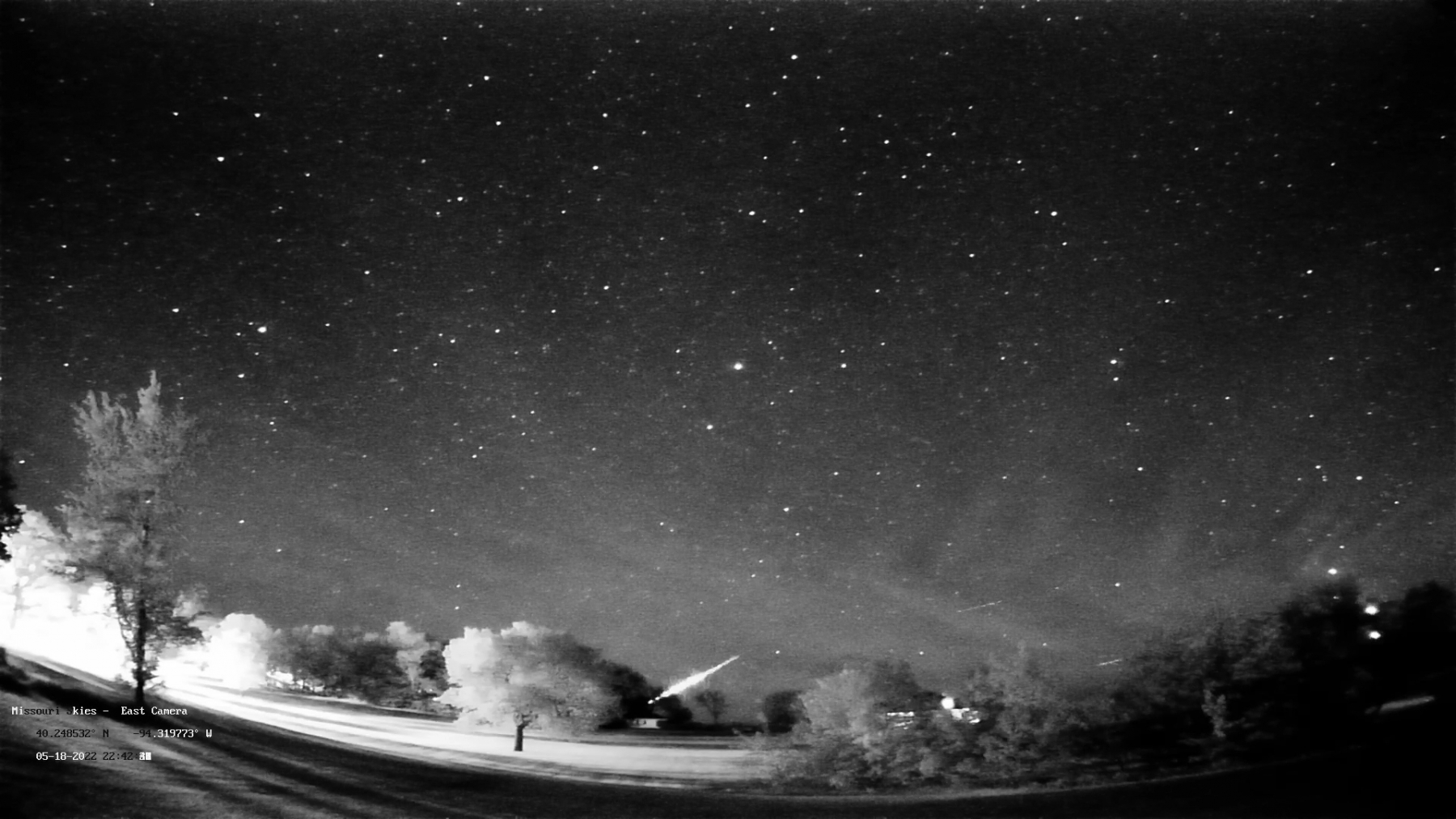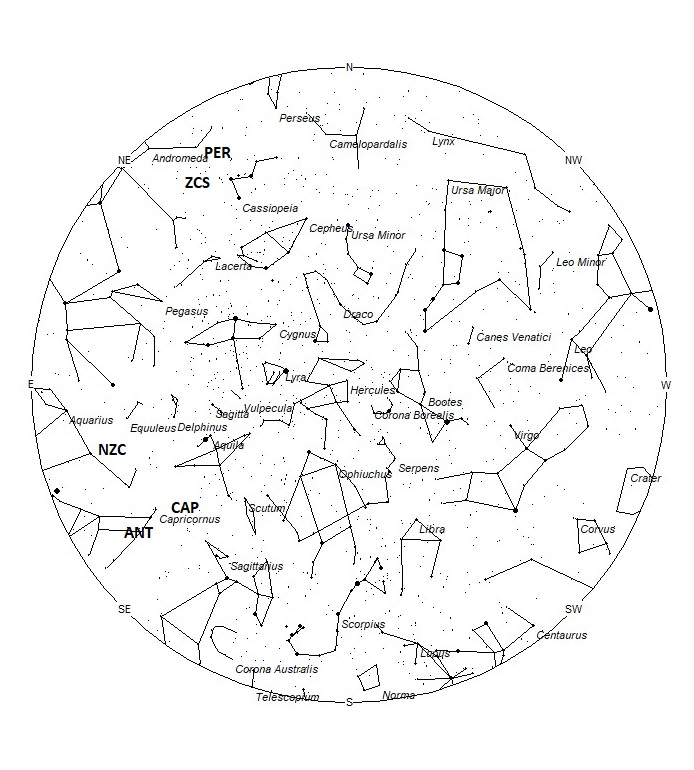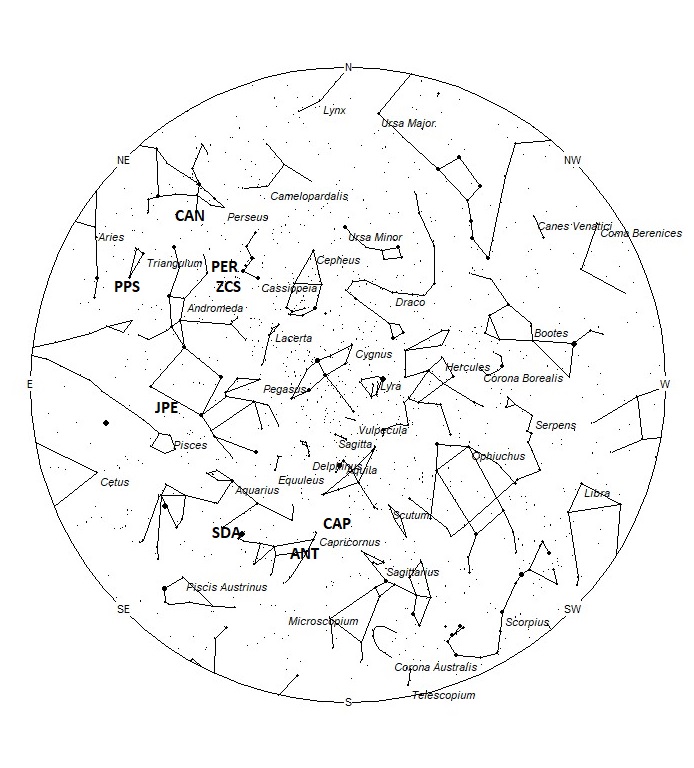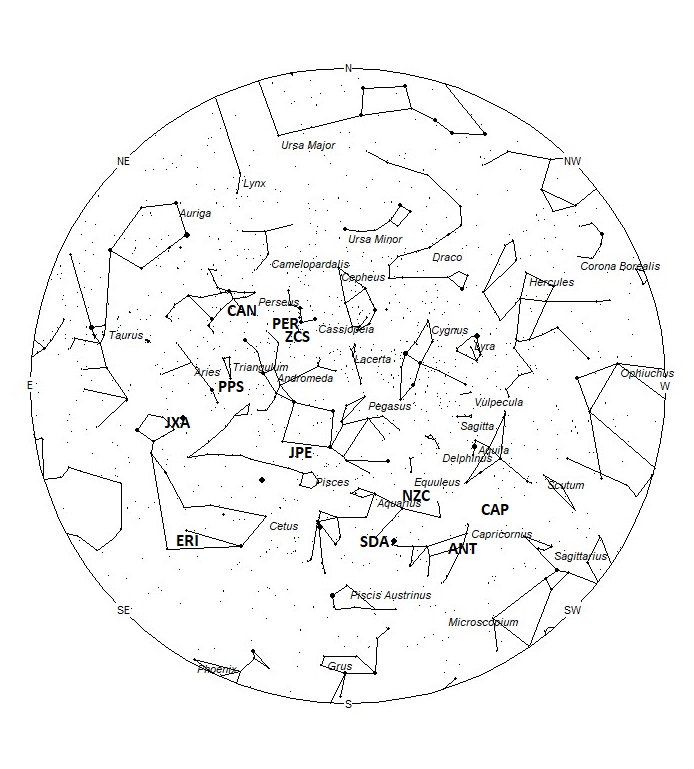 Daniel Bush captured this fireball low in the eastern sky at 03:42 UT (22:42 CDT) on April 19, 2022 (April 18th local date), from Albany, Missouri USA. For more information on this fireball visit: https://fireball.amsmeteors.org/members/imo_view/event/2022/2967 ©Daniel Bush
Daniel Bush captured this fireball low in the eastern sky at 03:42 UT (22:42 CDT) on April 19, 2022 (April 18th local date), from Albany, Missouri USA. For more information on this fireball visit: https://fireball.amsmeteors.org/members/imo_view/event/2022/2967 ©Daniel BushDuring this period, the moon reaches its last quarter phase on Wednesday July 20th. At that time the moon is located 90 degrees west of the sun and rises near midnight local Daylight Saving Time (LDST). This weekend the waning gibbous moon will rise during the late evening hours and will bathe the sky in bright moonlight the remainder of the night. Therefore, conditions for viewing meteor activity will be more favorable toward the end of this period. The estimated total hourly rates for evening observers this week should be near 3 as seen from mid-northern latitudes (45N) and 3 as seen from tropical southern locations (25S) For morning observers, the estimated total hourly rates should be near 9 as seen from mid-northern latitudes (45N) and 11 as seen from tropical southern locations (25S). Morning rates are reduced due to interfering moonlight. The actual rates will also depend on factors such as personal light and motion perception, local weather conditions, alertness, and experience in watching meteor activity. Note that the hourly rates listed below are estimates as viewed from dark sky sites away from urban light sources. Observers viewing from urban areas will see less activity as only the brighter meteors will be visible from such locations.
The radiant (the area of the sky where meteors appear to shoot from) positions and rates listed below are exact for Saturday night/Sunday morning July 16/17. These positions do not change greatly day to day so the listed coordinates may be used during this entire period. Most star atlases (available at science stores and planetariums) will provide maps with grid lines of the celestial coordinates so that you may find out exactly where these positions are located in the sky. I have also included charts of the sky that display the radiant positions for evening, midnight, and morning. The center of each chart is the sky directly overhead at the appropriate hour. These charts are oriented for facing south but can be used for any direction by rotating the charts to the desired direction. A planisphere or computer planetarium program is also useful in showing the sky at any time of night on any date of the year. Activity from each radiant is best seen when it is positioned highest in the sky, either due north or south along the meridian, depending on your latitude. It must be remembered that meteor activity is rarely seen at the radiant position. Rather they shoot outwards from the radiant, so it is best to center your field of view so that the radiant lies at the edge and not the center. Viewing there will allow you to easily trace the path of each meteor back to the radiant (if it is a shower member) or in another direction if it is sporadic. Meteor activity is not seen from radiants that are located far below the horizon. The positions below are listed in a west to east manner in order of right ascension (celestial longitude). The positions listed first are located further west therefore are accessible earlier in the night while those listed further down the list rise later in the night.
These sources of meteoric activity are expected to be active this week.
.
The alpha Capricornids (CAP) are active from July 7 through August 15, peaking on July 31st. The radiant is currently located at 19:57 (299) -12. This position lies in northwestern Sagittarius, 4 degrees west of the naked eye double star known as (alpha Capricornii). Current rates are expected to be near 1 per hour as seen from the Northern Hemisphere and 2 per hour as seen from south of the equator. These meteors are best seen near 01:00 LDST, when the radiant lies highest in the sky. With an entry velocity of 25 km/sec., the average meteor from this source would be of slow velocity.
The large Anthelion (ANT) is currently centered at 20:28 (307) -19. This position lies in western Capricornus, near the faint star known as pi Capricorni. This radiant is best placed near 02:00 LDST when it lies on the meridian and is highest in the sky. Rates at this time should be near 1 per hour as seen from the Northern Hemisphere and 2 as seen from south of the equator. With an entry velocity of 30 km/sec., the average Anthelion meteor would be of slow velocity.
The Northern June Aquilids (NZC) were discovered by Zdenek Sekanina in 1976. These meteors are active from June 26 through July 22 with maximum activity occurring on July 15. The radiant is currently located at 21:24 (321) -02. This area of the sky is located in northwest Aquarius, 4 degrees northwest of the of the 3rd magnitude star known as Sadalsuud (beta Aquarii). This radiant is best placed near 0300 LDST, when it lies on the meridian and is located highest in the sky. Hourly rates at this time should be less than 1 no matter your location. With an entry velocity of 37 km/sec., the average meteor from this source would be of medium-slow velocity. An interesting fact about this source is that it may be related to the Northern delta Aquariids of August. Where and when this source ends coincides with the start and position of the Northern delta Aquariids.
The Southern delta Aquariids (SDA) are now active from a radiant located at 22:04 (331) -18. This area of the sky is located in southwestern Aquarius, 4 degrees south of the 4th magnitude star known as iota Aquarii A. This location is also just a few degrees southeast of the first magnitude planet Saturn. This radiant is best placed near 0400 LDST, when it lies on the meridian and is located highest in the sky. Hourly rates at this time should be less than 1 as seen from the Northern Hemisphere and near 1 as seen from south of the equator. With an entry velocity of 42 km/sec., the average meteor from this source would be of medium velocity.
The July Pegasids (JPE) are active from July 4th through August 8th with maximum activity occurring on July 11th. The radiant is currently located at 23:33 (353) +13. This area of the sky is located in southern Pegasus, 6 degrees southeast of the 2nd magnitude star known as Markab (alpha Pegasi). This radiant is best placed near 0400 LDST, when it lies on the meridian and is located highest in the sky. Rates are expected to be less than 1 per hour this week no matter your location. With an entry velocity of 64 km/sec., the average meteor from this source would be of swift velocity.
The last of the zeta Cassiopeiids (ZCS) are expected this weekend from a radiant located at 00:39 (010) +51. This position lies in southern Cassiopeia near the faint star known as xi Cassiopeiae. Rates are currently expected to be less than 1 per hour no matter your location. These meteors are best seen near during the last dark hour of the night when the radiant lies highest in a dark sky. Observers in the northern hemisphere are better situated to view this activity as the radiant rises much higher in the sky before dawn compared to southern latitudes. With an entry velocity of 58 km/sec., the average zeta Cassiopeiid meteor would be of swift speed.
The first Perseids (PER) of the year should be sighted mid-week from a radiant located at 01:05 (016) +51. This position is not in Perseus, rather it lies in southern Cassiopeia, 4 degrees south of the 4th magnitude star known as theta Cassiopeiae. This area of the sky is best placed for viewing during the last dark hour before dawn when it lies highest in the sky. Maximum is not until August 13th so current rates are expected to be less than 1 no matter your location. With an entry velocity of 59 km/sec., the average meteor from this source would be of swift velocity.
The eta Eridanids (ERI) were discovered by the Tokyo Meteor Network back in 2001. The radiant is currently located near 01:38 (025) -20. This position lies in southern Cetus, 4 degrees south of the 3rd magnitude star known as tau Ceti. This source is active until September 10th, with maximum activity occurring on August 6th. Current rates would be less than 1 per hour no matter your location. These meteors are best seen during the last dark hour prior to dawn when the radiant lies highest above the horizon in a dark sky. It should be noted that this radiant rises during twilight for the northern half of the Northern Hemisphere. Therefore, these meteors are not visible until later in the activity period when nights become longer for the Northern Hemisphere. With an entry velocity of 64 km/sec., the average meteor from this source would be of swift speed.
The last of the phi Piscids (PPS) should be visible this week from a radiant located at 01:46 (027) +29. This position lies on the Triangulum/Pisces border, 1 degree southwest of the 3rd magnitude star known as Mothallah (alpha Trianguli). Current rates should be less than 1 meteor per hour no matter your location. This area of the sky lies highest in a dark sky during the last hour prior to dawn. The mean velocity of 67km/sec. would produce swift meteors.
The July chi Arietids (JXA) were discovered by two investigating teams in Europe using video data from European video Meteor Network Database (EDMOND), SonotaCo, 2013; and CMN, 2013. Activity from this stream is seen from June 26 through July 22 with maximum activity occurring on July 7. The radiant currently lies at 02:30 (037) +10, which places it in extreme northwestern Cetus, 2 degrees northeast of the 4th magnitude star known as xi2 Ceti. This position is also just 2 degrees south of the 1st magnitude orange planet Mars. This area of the sky is best seen during the last dark hour before dawn when the radiant lies highest in a dark sky. Current rates are expected to be less than 1 no matter your location. With an entry velocity of 69 km/sec., the average meteor from this source would be of swift velocity.
The c-Andromedids (CAN) were discovered by Sirko Molau and Juergen Rendtel using video data from the IMO network. Activity from this source is seen from June 21 through July 28 with maximum activity occurring on July 12. The radiant currently lies at 02:36 (039) +50, which places it on the Andromeda/Perseus border, 1 degree northwest of the 4th magnitude star known as theta Persei. This area of the sky is best seen during the last dark hour before dawn when the radiant lies highest in a dark sky. Observers in the northern hemisphere are better situated to view this activity as the radiant rises much higher in the sky before dawn compared to southern latitudes. Current rates would be less than 1 per hour no matter your location. With an entry velocity of 57 km/sec., the average meteor from this source would be of swift velocity.
As seen from the mid-northern hemisphere (45N) one would expect to see approximately 7 sporadic meteors per hour during the last hour before dawn as seen from rural observing sites. Evening rates would be near 2 per hour. As seen from the tropical southern latitudes (25S), morning rates would be near 7 per hour as seen from rural observing sites and 2 per hour during the evening hours. Locations between these two extremes would see activity between the listed figures. Morning rates are reduced by moonlight.
You can keep track of the activity of these meteor showers as well as those beyond the limits of visual observing by visiting the NASA Meteor Shower Portal available at: https://meteorshowers.seti.org/ You can move the sky globe to see different areas of the sky. Colored dots indicate shower meteors while white dots indicate sporadic (random) activity. The large orange disk indicates the position of the sun so little activity will be seen in that area of the sky.
The list below offers the information from above in tabular form. Rates and positions are exact for Saturday night/Sunday morning except where noted in the shower descriptions.
| SHOWER | DATE OF MAXIMUM ACTIVITY | CELESTIAL POSITION | ENTRY VELOCITY | CULMINATION | HOURLY RATE | CLASS |
| RA (RA in Deg.) DEC | Km/Sec | Local Daylight Saving Time | North-South | |||
| alpha Capricornids (CAP) | Jul 31 | 19:57 (299) -12 | 25 | 01:00 | 1 – 2 | II |
| Anthelion (ANT) | – | 20:28 (307) -19 | 30 | 02:00 | 1 – 2 | II |
| Northern June Aquilids (NZC) | Jul 15 | 21:24 (321) -02 | 37 | 03:00 | <1 – <1 | IV |
| Southern delta Aquariids (SDA) | Jul 31 | 22:04 (331) -18 | 42 | 04:00 | <1 – 1 | I |
| July Pegasids (JPE) | Jul 11 | 23:33 (353) +13 | 64 | 05:00 | <1 – <1 | II |
| zeta Cassiopeiids (ZCS) | Jul 16 | 00:39 (010) +51 | 58 | 06:00 | <1 – <1 | IV |
| Perseids (PER) | Aug 13 | 01:05 (016) +51 | 59 | 06:00 | <1 – <1 | I |
| eta Eridanids (ERI) | Aug 06 | 01:38 (025) -20 | 64 | 07:00 | <1 – <1 | II |
| phi Piscids (PPS) | Jul 10 | 01:46 (027) +29 | 67 | 07:00 | <1 – <1 | IV |
| July chi Arietids (JXA) | Jul 07 | 02:30 (037) +10 | 69 | 08:00 | <1 – <1 | IV |
| c-Andromedids (CAN) | Jul 12 | 02:36 (039) +50 | 57 | 08:00 | <1 – <1 | IV |
 American Meteor Society
American Meteor Society



For those of us without a college degree please include simple instructions such as: to see these meteors best, look to the east at 4:00 am.
Thanks for the weekly updates. Definitely appreciate the realistic hourly rate predictions. Gotta laugh at other sites that claim 200 per hour. Would be thrilled with 20. Have a good day!
Too difficult to just say lookin a particular direction around a certain time. You’re trying to demonstrate your knowledge, but you are a poor instructor.